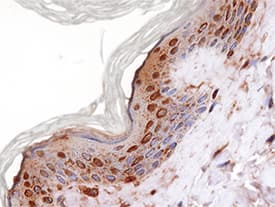Human Syndecan-2/CD362 Antibody
R&D Systems, part of Bio-Techne | Catalog # AF2965

Key Product Details
Species Reactivity
Validated:
Cited:
Applications
Validated:
Cited:
Label
Antibody Source
Product Specifications
Immunogen
Glu19-Glu144
Accession # AAH49836
Specificity
Clonality
Host
Isotype
Scientific Data Images for Human Syndecan-2/CD362 Antibody
Syndecan-2/CD362 in Human Skin.
Syndecan-2/CD362 was detected in immersion fixed paraffin-embedded sections of human skin using Goat Anti-Human Syndecan-2/CD362 Antigen Affinity-purified Polyclonal Antibody (Catalog # AF2965) at 15 µg/mL overnight at 4 °C. Tissue was stained using the Anti-Goat HRP-DAB Cell & Tissue Staining Kit (brown; Catalog # CTS008) and counterstained with hematoxylin (blue). Specific staining was localized to keratinocytes. View our protocol for Chromogenic IHC Staining of Paraffin-embedded Tissue Sections.Applications for Human Syndecan-2/CD362 Antibody
Immunohistochemistry
Sample: Immersion fixed paraffin-embedded sections of human skin
Formulation, Preparation, and Storage
Purification
Reconstitution
Formulation
Shipping
Stability & Storage
- 12 months from date of receipt, -20 to -70 °C as supplied.
- 1 month, 2 to 8 °C under sterile conditions after reconstitution.
- 6 months, -20 to -70 °C under sterile conditions after reconstitution.
Background: Syndecan-2/CD362
Syndecan-2, previously known as fibroglycan or heparan sulfate proteoglycan, is a member of the syndecan family of Type 1 transmembrane proteins capable of carrying heparan sulfate (HS) and chondroitin sulfate glycosaminoglycans. The four vertebrate syndecans show conserved cytoplasmic domains and divergent extracellular portions (except for GAG attachment sites). Among the Syndecans, Syndecan-2 is most similar to Syndecan-4 (1‑3). Human Syndecan-2 is synthesized as a 201 amino acid (aa) core protein with an 18 aa signal sequence, a 126 aa extracellular domain (ECD), a 25 aa transmembrane region and a 32 aa cytoplasmic tail (4). The human ECD of Syndecan-2 contains three closely-spaced consensus Ser-Gly sequences for the attachment of HS side chains. It shares 76%, 73%, 87%, 78% and 63% aa identity with the ECD of mouse, rat, bovine, canine and chicken Syndecan-2, respectively. The cytoplasmic tail has both serine and tyrosine phosphorylation sites. Addition of 20‑80 disaccharides per side chain adds considerably to the size of the 22 kDa core protein. Non-covalent homodimerization of Syndecan-2 is dependent on the transmembrane domain (5). Syndecan-2 is expressed in cells of mesenchymal origin, neuronal and epithelial cells, and is the predominant syndecan expressed during embryonic development. Expression is upregulated in several cancer cell lines (6). After induction in macrophages by inflammatory mediators, Syndecan-2 selectively binds FGFbasic, VEGF and EGF (7). Syndecan-2 expressed on human primary osteoblasts binds GM-CSF and may function as a co-receptor (8). Activated endothelial cell Syndecan-2 specifically binds IL-8 and may participate in promoting neutrophil extravasation by forming a chemotactic IL-8 gradient (9). Typically, cytokine, chemokine and extracellular matrix protein binding occurs through interaction with HS side chains, but the Syndecan-2 extracellular domain can bind TGF-beta directly via protein-protein interaction (10).
References
- Tkachenko, E. et al. (2005) Circ. Res. 96:488.
- Oh, E.-S, and J. R. Couchman (2004) Mol. Cells 17:181.
- Essner, J. J. et al. (2006) Int. J. Biochem. Cell Biol. 38:152.
- Marynen, P. et al. (1989) J. Biol. Chem. 264:7017.
- Choi, S. et al. (2005) J. Biol. Chem. 280:42573.
- Park, H. et al. (2002) J. Biol. Chem. 277:29730.
- Clasper, S. et al. (1999) J. Biol. Chem. 274:24113.
- Modrowski, D. et al. (2000) J. Biol. Chem. 275:9178.
- Halden, Y. et al. (2004) Biochem. J. 377:533.
- Chen, L. et al. (2004) J. Biol. Chem. 279:15715.
Alternate Names
Gene Symbol
UniProt
Additional Syndecan-2/CD362 Products
Product Documents for Human Syndecan-2/CD362 Antibody
Product Specific Notices for Human Syndecan-2/CD362 Antibody
For research use only
